 W
WThe apical flycatcher is a species of bird in the family Tyrannidae.
 W
WThe Arabian wheatear is a species of bird in the family Muscicapidae. It is found in Oman, Saudi Arabia and Yemen.
 W
WThe ash-winged antwren is an insectivorous bird in the antbird family Thamnophilidae. It is found in Brazil, Colombia, Ecuador, French Guiana, Guyana, Peru, Suriname, and Venezuela. Its natural habitat is subtropical or tropical moist lowland forests.
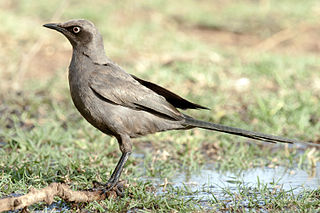 W
WThe ashy starling is a species of starling in the family Sturnidae. It is found in Kenya and Tanzania. It is alternatively placed in the genus Cosmopsarus or Spreo.
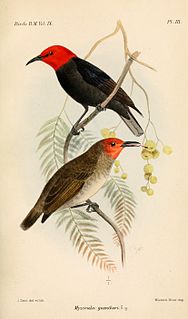 W
WThe black-bellied myzomela, also known as the splendid myzomela, is a species of bird in the family Meliphagidae. It is endemic to the large island of New Britain, near New Guinea. Its natural habitat is subtropical or tropical moist lowland forests.
 W
WThe blue-rumped pitta is a species of bird in the family Pittidae. It is found in Cambodia, China, Laos, Thailand, and Vietnam. Its natural habitats are subtropical or tropical moist lowland forest and subtropical or tropical moist montane forest.
 W
WThe brown nunlet is a species of puffbird in the family Bucconidae.
 W
WThe brown-bellied stipplethroat or brown-bellied antwren is a species of bird in the family Thamnophilidae.
 W
WThe brown-winged starling is a species of starling in the family Sturnidae. It is found in the Solomon Islands archipelago. Its natural habitat is subtropical or tropical moist lowland forests.
 W
WThe buff-crested bustard is a species of bird in the family Otididae. It is found in Djibouti, Ethiopia, Kenya, Somalia, South Sudan, Tanzania, and Uganda.
 W
WCabanis's greenbul, also known as Cabanis's bulbul, is a species of songbird in the bulbul family, Pycnonotidae. It is found in east-central and south-central Africa. Its natural habitats are subtropical or tropical dry forest, subtropical or tropical moist lowland forest, subtropical or tropical moist montane forest, and subtropical or tropical moist shrubland.
 W
WThe California gnatcatcher is a small 10.8 cm (4.3 in) long insectivorous bird which frequents dense coastal sage scrub growth. This species was recently split from the similar black-tailed gnatcatcher of the Sonoran and Chihuahuan deserts. This bird is often solitary, but joins with other birds in winter flocks.
 W
WThe coppery emerald is a species of hummingbird in the family Trochilidae. It is found in the Sierra Nevada de Santa Marta and Serranía del Perijá.
 W
WCory's shearwater is a large shearwater in the seabird family Procellariidae. The genus name Calonectris comes from Ancient Greek kalos, "good" and nectris, "swimmer", and borealis is Latin for "northern". The English name is after the American ornithologist Charles B. Cory.
 W
WThe fiery-shouldered parakeet, also known as the fiery-shouldered conure, is a species of parrot in the family Psittacidae. It is found in Brazil, Guyana, and Venezuela. Its natural habitat is subtropical or tropical moist montane forests. There are two subspecies, P. e. egregia and P. e. obscura.
 W
WFinsch's pygmy parrot, also known as the emerald pygmy parrot and green pygmy parrot, is a member of parrot family Psittacidae inhabiting tropical rainforest regions of islands in Papua New Guinea, the Solomon Islands, and the Bismarck Archipelago.
 W
WThe golden-tufted mountain grackle, also known as the golden-tufted grackle, is a species of bird in the family Icteridae.
 W
WThe grey-capped warbler is a species of bird in the Cisticola family Cisticolidae. It is the only species in the genus Eminia. The grey-capped warbler is found in Burundi, Democratic Republic of the Congo, Kenya, Rwanda, South Sudan, Tanzania, and Uganda. Is a large, chunky, thin-tailed- warbler with a distinctive grey cap, black band that's around its head, and a chestnut throat wrapping its neck. They maintain a diet of insects and other invertebrates, including caterpillars, moths, grasshoppers, mantids, etc.
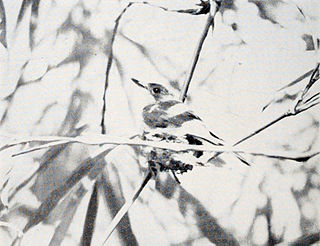 W
WThe Guam flycatcher, or Guam broadbill, is an extinct species of bird in the family Monarchidae formerly endemic to Guam.
 W
WHume's treecreeper was earlier included within the brown-throated treecreeper complex and identified as a separate species on the basis of their distinctive calls. This species in the treecreeper family is found in Assam, Myanmar, Shan Mountains, Laos and the Dalat Plateau.
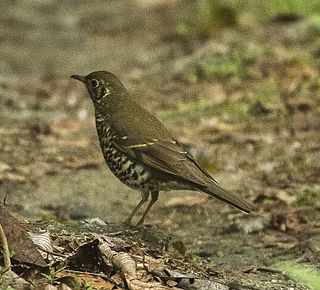 W
WThe long-tailed thrush is a species of bird in the family Turdidae. It is found from the central and eastern Himalayas to south-central and south-western China. Its natural habitats are subtropical or tropical moist montane forests and subtropical or tropical high-altitude shrubland.
 W
WLucy's warbler is a small New World warbler found in North America. This species ranges includes southwestern United States and northwestern Mexico. It is one of only two warblers to nest in cavities.
 W
WThe malia is a medium-sized babbler-like passerine. It has an olive-green plumage, yellowish head and chest, and pinkish-brown bill. The young is duller than adult. It is the only member of the genus Malia.
 W
WThe Mexican whip-poor-will,, is a medium-sized (22–27 cm) nightjar from the southwestern United States and Mexico. The whip-poor-will is more often heard within its range, but less often seen. It is named onomatopoeically after its song.
 W
WMrs. Hume's pheasant, also known as Hume's pheasant or the bar-tailed pheasant, is a large, up to 90 cm long, forest pheasant with a greyish brown head, bare red facial skin, chestnut brown plumage, yellowish bill, brownish orange iris, white wingbars and metallic blue neck feathers. The male has a long greyish white, barred black and brown tail. The female is a chestnut brown bird with whitish throat, buff color belly and white-tipped tail.
 W
WThe New Caledonian owlet-nightjar, also known as the enigmatic owlet-nightjar, is a large owlet-nightjar with vermiculated grey-brown and black plumage. It has a long, slightly rounded tail, short, rounded wings, and long, stout legs. Its voice is unknown, but other owlet-nightjar species make churring and whistling sounds. It is the second-largest known owlet-nightjar, much larger than the Australian owlet-nightjar.
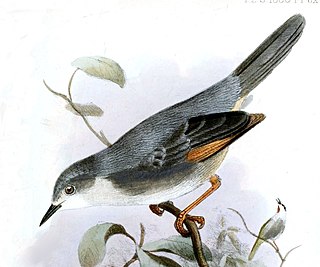 W
WThe red-winged grey warbler is a species of bird in the family Cisticolidae. It is monotypic within the genus Drymocichla. It is found in Cameroon, Central African Republic, Democratic Republic of the Congo, South Sudan, and Uganda. Its natural habitats are moist savanna and subtropical or tropical moist shrubland.
 W
WThe royal parrotfinch is a species of estrildid finch endemic to Vanuatu in the South Pacific Ocean. It is found commonly at mid-altitudes on the larger islands such as Espiritu Santo, above 300 m., but it also can be found at small sea-level islands in fruiting figs in forest edge in Emae and Tongoa. This species is usually found in singles, pairs or small groups feeding on figs in the forest canopy.
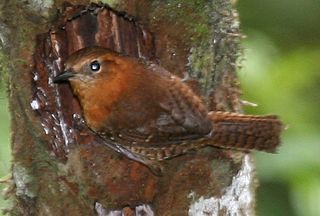 W
WThe rufous-browed wren is a species of bird in the family Troglodytidae. It is found in El Salvador, Guatemala, Honduras, Mexico, and Nicaragua. Its natural habitat is subtropical or tropical moist montane forests.
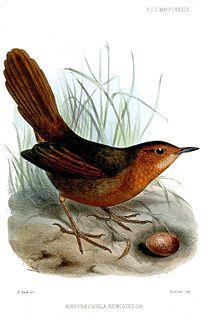 W
WThe rusty thicketbird is a bird species. Previously placed in the "Old World warbler" family Sylviidae, it does not seem to be a close relative of the typical warblers; probably it belongs in the grass warbler family Locustellidae. It is found in New Britain only.
 W
WThe rusty-bellied brushfinch is a species of bird in the family Passerellidae.
 W
WThe rusty-browed warbling finch is a species of bird in the family Thraupidae. It is found in Argentina and Bolivia. Its natural habitat is subtropical or tropical moist montane forests.
 W
WThe rusty-crowned tit-spinetail is a species of bird in the family Furnariidae. It is endemic to Peru.
 W
WThe sepia-brown wren or Sharpe's wren is a species of bird in the family Troglodytidae. It was formerly considered a subspecies of the Peruvian wren, but under the common name sepia-brown wren. As presently defined, the sepia-brown wren is found in dense undergrowth of humid Andean forests in Colombia, Ecuador, and northern Peru.
 W
WThe Socotra golden-winged grosbeak or Socotra grosbeak is a finch endemic to Socotra, an island in the Indian Ocean off the coast of Yemen. R. socotranus is by some authorities held to be the only species of the then-monotypic genus Rhynchostruthus, including all other golden-winged grosbeaks therein as subspecies. But in recent times the three populations are usually considered a distinct species, with R. socotranus being limited to the Socotra population, the Arabian golden-winged grosbeak becoming R. percivali, and the Somali golden-winged grosbeak R. louisae.
 W
WThe Socotra sparrow is a passerine bird endemic to the islands of Socotra, Samhah, and Darsah in the Indian Ocean, off the Horn of Africa. The taxonomy of this species and its relatives is complex, with some authorities, including BirdLife International, recognising this species and the very similar Abd al-Kuri sparrow, as well as several from mainland Africa, as separate, and others lumping all these species and the probably unrelated Iago sparrow.
 W
WThe Socotra starling is a species of starling in the family Sturnidae. It is endemic to Yemen.
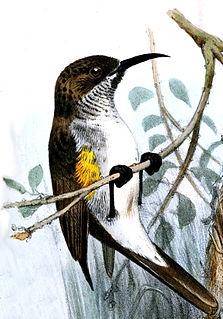 W
WThe Socotra sunbird is a species of bird in the family Nectariniidae. It is endemic to Socotra.
 W
WThe Socotra warbler is a species of bird in the family Cisticolidae. It is monotypic within the genus Incana. It is endemic to Socotra. Its natural habitats are subtropical or tropical dry shrubland and subtropical or tropical high-altitude shrubland. It is threatened by habitat loss.
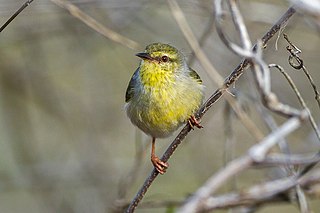 W
WThe stripe-throated jery is a species of bird in the family Cisticolidae. It is endemic to Madagascar.
 W
WThe Sulu pygmy woodpecker, also known as the Sulu woodpecker, is a species of bird in the family Picidae. Formerly lumped with the Philippine pygmy woodpecker, it seems to form a superspecies with this and the Sulawesi pygmy woodpecker. Some taxonomic authorities continue to place this species in the genus Dendrocopos or Picoides.
 W
WThe three-banded warbler is a species of bird in the family Parulidae. It is found in Ecuador and Peru. Its natural habitats are subtropical or tropical moist montane forests and heavily degraded former forest.
 W
WThe Tibetan blackbird is a member of the thrush family Turdidae. It was formerly considered a subspecies of the common blackbird. It is found in the Himalayas from northern Pakistan to southeastern Tibet. It is strikingly different from the common blackbird, being relatively large at 23–28 centimetres length. It also differs from the common blackbird by its complete lack of eye-ring and reduced song.
 W
WThe Tibetan eared pheasant, also called Elwes' eared pheasant, is a species of bird in the family Phasianidae found in southeast Tibet and adjacent northern India, usually between 3,000 and 5,000 m elevation, but has been seen down to 2,280 m (7,500 ft) in winter.
 W
WThe white-bellied tit is a species of bird in the family Paridae. It is found in Cameroon, Kenya, Nigeria, South Sudan, Tanzania, and Uganda. Its natural habitats are subtropical or tropical dry forests and subtropical or tropical moist montane forests.
 W
WThe white-capped monarch, or Richards' monarch, is a species of bird in the family Monarchidae. It is endemic to the Western Province in the Solomon Islands.
 W
WThe white-throated greenbul, or white-throated bulbul, is a species of songbird in the bulbul family, Pycnonotidae. It is found in many parts of central and western Africa. Its natural habitats are subtropical or tropical moist lowland forests and subtropical or tropical moist montane forests.